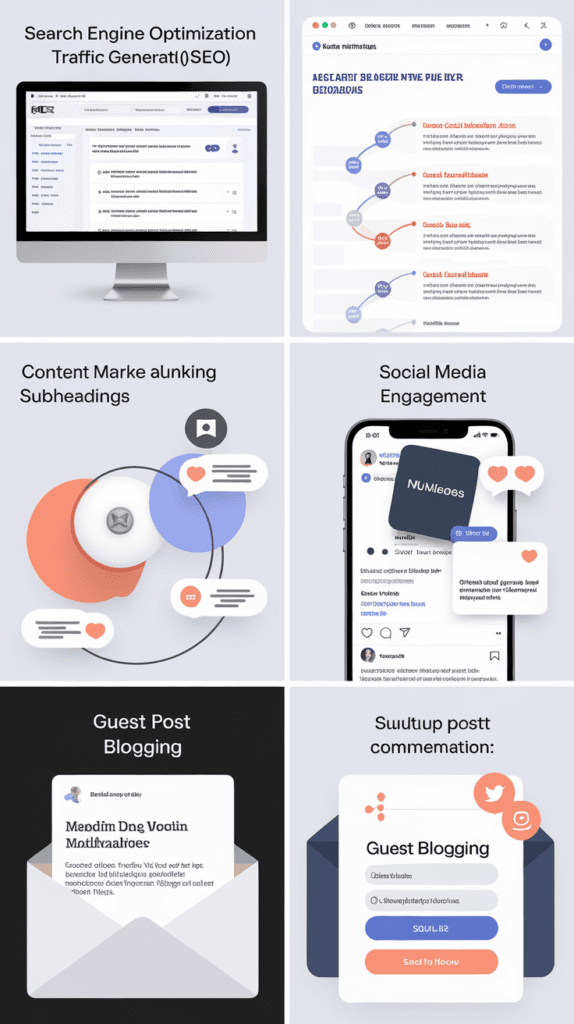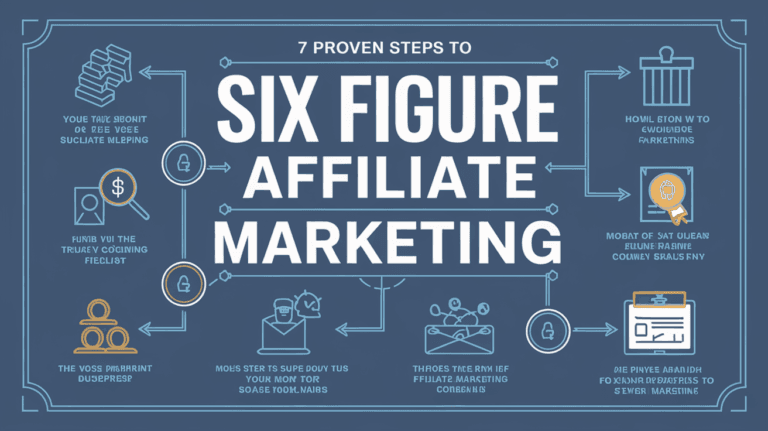Affiliate Marketing Crash Course: Master Passive Income Today
Affiliate marketing can be a powerful tool. It’s a way to earn money by promoting others’ products.
Do you want to understand affiliate marketing better? This crash course is just what you need. Affiliate marketing involves promoting products and earning a commission. It’s a popular way to make money online. Many people find success with it. But, it requires learning and strategy.
This course will guide you through the basics. You’ll learn how to choose the right products. You’ll also discover how to attract an audience. By the end, you’ll know the steps to start earning. Ready to dive in? Let’s get started on your affiliate marketing journey!

Introduction To Affiliate Marketing
Welcome to the Affiliate Marketing Crash Course! If you are new to this, you are in the right place. This section will give you a clear understanding of what affiliate marketing is and its benefits. Let’s dive in!
What Is Affiliate Marketing?
Affiliate marketing is a way to earn money online. You promote someone else’s products or services. When someone buys through your link, you get a commission. It’s that simple.
You don’t need to create your own product. You just help others sell theirs. Your job is to attract customers. You can use blogs, social media, or other platforms to do this.
Benefits Of Affiliate Marketing
There are many benefits to affiliate marketing. First, it’s low cost. You don’t need to invest a lot of money to start. You can begin with a website and some content.
Second, it offers flexibility. You can work from anywhere. You can choose your own hours. This makes it great for people with busy schedules.
Third, it can be a source of passive income. Once you set up your links, you can earn money even while you sleep. Your content keeps working for you.
Finally, you can choose from many products. There are affiliate programs in every niche. You can promote what you love and know well. This makes it easier and more enjoyable.
How Affiliate Marketing Works
Affiliate marketing can seem confusing at first. But understanding how it works makes it easier to get started. This guide breaks down the process step-by-step.

Key Players In Affiliate Marketing
Affiliate marketing involves three main players. First, there is the merchant or advertiser. This is the company or person selling the product or service.
Next, we have the affiliate or publisher. This person promotes the merchant’s products. They use websites, blogs, or social media to reach potential customers.
Finally, there is the consumer. This is the person who clicks on the affiliate’s link and makes a purchase.
Commission Structures
Commission structures vary in affiliate marketing. The most common type is pay-per-sale. The affiliate earns a percentage of the sale each time a customer buys through their link.
Another type is pay-per-click. The affiliate gets paid for each click on their link. This does not require a purchase. It’s based on traffic generation.
There is also pay-per-lead. Affiliates earn a commission when visitors complete a desired action. Actions include signing up for a newsletter or filling out a form.
Choosing The Right Niche
Choosing the right niche is crucial for your success in affiliate marketing. Selecting a niche that aligns with your interests and has the potential for profit can make a significant difference. Let’s dive into the key aspects of choosing the right niche.
Identifying Profitable Niches
To identify profitable niches, start with your interests. What are you passionate about? What do you enjoy discussing or learning about? Next, consider the profitability of these interests. Use tools like Google Trends or keyword research tools to gauge the interest levels.
Here’s a simple table to illustrate some profitable niches:
| Niche | Potential Earnings |
|---|---|
| Health & Wellness | High |
| Technology | Medium |
| Personal Finance | High |
| Travel | Medium |
Evaluating Market Demand
Once you’ve identified a few potential niches, the next step is to evaluate market demand. Check if there is a large audience interested in the niche. You can do this by:
- Looking at search volumes for related keywords.
- Checking out forums and social media groups.
- Analyzing competitors’ performance in the niche.
High demand niches often have higher competition. But don’t be discouraged. Competition also means there is money to be made.
Here’s a quick guide to evaluate market demand:
- Use keyword research tools to find monthly search volumes.
- Join forums or groups related to your niche to see engagement levels.
- Analyze top blogs or websites in your niche for their traffic and engagement.
By following these steps, you can choose a niche that is both interesting and profitable. This sets a strong foundation for your affiliate marketing journey.
Finding Affiliate Programs
Finding the right affiliate programs is crucial for your affiliate marketing success. The right programs can help you earn more and build a sustainable income stream. So, how do you find these programs? Let’s explore some key strategies to help you get started.
Top Affiliate Networks
Affiliate networks connect you with various affiliate programs. Some popular networks include ClickBank, Amazon Associates, and ShareASale. Each network has its own set of programs, making it easier to find products that fit your niche.
ClickBank offers a wide range of digital products. Amazon Associates is great for physical products. ShareASale provides a mix of both. Joining multiple networks can give you access to a variety of programs.

Evaluating Program Terms
Before joining an affiliate program, check the terms. Look for the commission rate. Higher rates mean more earnings per sale. Also, check the cookie duration. Longer durations increase your chances of earning a commission.
Review the payment methods. Some programs offer direct deposit, while others use PayPal. Make sure the method works for you. Also, consider the minimum payout threshold. Some programs require you to earn a certain amount before you get paid.
Lastly, check the support provided. Good support can help you succeed. Look for programs that offer resources like banners, text links, and marketing tips. This can make promoting the products easier.
Creating Engaging Content

Creating engaging content is crucial in affiliate marketing. Quality content attracts and retains your audience. It also boosts conversions. Let’s explore some effective strategies for creating engaging content.
Content Types That Convert
Different content types can drive conversions. Here are some effective ones:
- Product Reviews: Write honest and detailed reviews. Highlight pros and cons.
- How-to Guides: Create step-by-step guides. Solve specific problems.
- Comparison Posts: Compare similar products. Help users make informed decisions.
- Tutorial Videos: Make engaging videos. Show product usage and benefits.
- Listicles: Write list-based articles. Easy to read and share.
Seo Best Practices
SEO is vital for content visibility. Follow these best practices:
- Keyword Research: Use tools like Google Keyword Planner. Find relevant keywords.
- On-Page SEO: Use keywords in titles, headings, and content. Ensure natural flow.
- Meta Descriptions: Write compelling meta descriptions. Include primary keywords.
- Internal Linking: Link to related content on your site. Improve navigation and SEO.
- External Linking: Link to reputable sources. Enhance credibility and SEO.
Quick Tips:
| Tip | Description |
|---|---|
| Use Short Paragraphs | Improve readability and engagement. |
| Include Multimedia | Add images and videos. Break text monotony. |
| Write Catchy Headlines | Grab attention and encourage clicks. |
Remember, creating engaging content is an ongoing process. Keep your audience in mind. Adapt and refine your strategies for the best results.
Driving Traffic To Your Content
So, you have created amazing content for your affiliate marketing. Now, you need people to see it. Driving traffic to your content is crucial. Without traffic, your efforts won’t pay off. Let’s look at effective methods to attract visitors.
Organic Traffic Strategies

Organic traffic is free and sustainable. Here are some strategies:
- Search Engine Optimization (SEO): Optimize your content with relevant keywords. Use headings, meta descriptions, and alt text for images.
- Content Marketing: Create valuable content that solves problems. Blog posts, videos, and infographics can attract visitors.
- Social Media Engagement: Share your content on social platforms. Engage with your audience through comments and shares.
- Guest Blogging: Write for other blogs in your niche. Include a link back to your site.
Paid Traffic Options
Paid traffic can bring quick results. Here are some options:
| Method | Description |
|---|---|
| Pay-Per-Click (PPC) Ads | Use platforms like Google Ads. Pay for each click to your site. |
| Social Media Ads | Run ads on Facebook, Instagram, or Twitter. Target specific audiences. |
| Influencer Marketing | Collaborate with influencers. They promote your content to their followers. |
| Display Ads | Use banner ads on related websites. Pay based on impressions or clicks. |
By combining these strategies, you can drive significant traffic to your content. Organic methods build a strong foundation. Paid options bring immediate results. Experiment to find what works best for your audience.
Analyzing Performance
Analyzing performance is crucial for success in affiliate marketing. It helps you understand what works and what doesn’t. By tracking key metrics and using analytics tools, you can make informed decisions to boost your earnings. Let’s delve into the essential aspects of analyzing performance.

Key Metrics To Track
Tracking key metrics is the first step. These metrics give you a clear picture of your performance. Focus on metrics like conversion rate, click-through rate (CTR), and average order value (AOV). Each one tells you something different about your success.
Conversion rate shows how many visitors make a purchase. CTR indicates how many clicks your links get. AOV reveals the average amount spent per order. Keep an eye on these numbers to gauge your progress.
Using Analytics Tools
Analytics tools are your best friends in affiliate marketing. They help you track and analyze your metrics. Google Analytics is a popular choice. It offers detailed insights into your traffic and conversions.
Other tools like SEMrush and Ahrefs provide valuable data on keywords and backlinks. They help you optimize your content and improve your rankings. Use these tools to refine your strategies and boost your performance.
Regularly check your analytics to stay informed. Adjust your tactics based on the data you collect. This will help you achieve better results over time.
Best SEO Tools

Scaling Your Affiliate Business
Scaling an affiliate business can bring more revenue and opportunities. It requires smart strategies and careful planning. Here’s how you can take your affiliate business to the next level.

Automating Processes
Automating tasks saves time and reduces errors. Use tools to handle repetitive tasks. Email marketing can be automated for consistent communication. Automate social media posts to maintain a steady online presence. Track and analyze data with automated tools. Automation helps in focusing on growth strategies.
Expanding To New Markets
Expand your reach by targeting new markets. Research markets that align with your niche. Consider cultural differences and language. Create content that resonates with the new audience. Use local influencers to build trust. Tailor your marketing strategies for each market. Expanding to new markets increases your potential customer base.
Common Mistakes To Avoid
Starting your journey in affiliate marketing can be exciting. But many new affiliates make common mistakes that can hurt their progress. Avoid these pitfalls to ensure a smoother path to success.

Overpromising Products
Many affiliates make the mistake of overpromising. They claim products can do more than they actually can. This can lead to disappointment. Always provide an honest review. Set clear expectations. Honesty builds trust with your audience. When trust is broken, it’s hard to regain.
Ignoring Compliance Rules
Compliance rules are there for a reason. Ignoring them can lead to penalties. Always disclose your affiliate links. This is not just good practice. It’s a legal requirement in many places. Review the guidelines of each platform you use. Following the rules can save you a lot of trouble. Stay compliant and keep your business safe.
Future Trends In Affiliate Marketing
The future of affiliate marketing holds exciting opportunities for marketers and businesses. Technology keeps evolving, and consumer behavior shifts constantly. Staying updated with these trends can help you stay ahead of the competition. Let’s dive into some key trends shaping the future of affiliate marketing.
Emerging Technologies
Emerging technologies are transforming the affiliate marketing landscape. These technologies help streamline processes and improve performance.
- Artificial Intelligence (AI): AI tools analyze data and predict trends. They help marketers optimize campaigns and target audiences better.
- Blockchain: Blockchain ensures transparency and trust. It secures transactions and protects against fraud in affiliate networks.
- Chatbots: Chatbots engage with users in real-time. They provide personalized experiences and drive conversions.
Shifts In Consumer Behavior
Consumer behavior changes impact how affiliate marketing strategies are developed. Understanding these shifts can help marketers adapt and succeed.
- Mobile Usage: More consumers use mobile devices for shopping. Optimize your content for mobile to reach a broader audience.
- Personalization: Consumers expect personalized experiences. Tailor your content and offers to meet their needs.
- Social Media Influence: Social media platforms drive purchasing decisions. Leverage influencers and engage with your audience on these platforms.
Frequently Asked Questions
What Is Affiliate Marketing?
Affiliate marketing is a performance-based strategy where affiliates earn commissions by promoting products or services of a company.
How Does Affiliate Marketing Work?
Affiliates promote products using unique links. They earn a commission when sales are made through these links.
Why Is Affiliate Marketing Popular?
Affiliate marketing is popular because it offers a low-risk, high-reward model for both businesses and affiliates.
Can Beginners Succeed In Affiliate Marketing?
Yes, beginners can succeed with proper education, consistent effort, and choosing the right niche and products.
Conclusion
Affiliate marketing offers a great way to earn extra income. Start with simple, small steps. Choose a niche that interests you. Create quality content to attract your audience. Consistency and patience are key. Track your progress and adjust your strategies.
Learn from your mistakes and stay updated with trends. Soon, you will see results. Happy marketing!







